Ghana. A Journey into Asante’s Cultural Heritage.
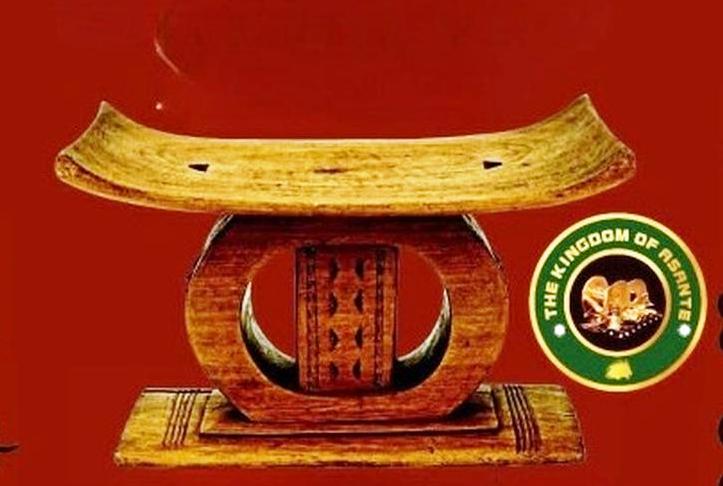
The Asante are a group of people who form part of the Akan ethnic group in the central part of Ghana in the West African Sub-region.
The Asantes were one Akan-speaking people who settled in the forest region of modern Ghana between the 11th and 13th centuries. They are known to have migrated to present-day Ghana and other parts of West Africa from the Sahel and the Sahara Desert regions of Africa.
The name Asante, which means because of war, came to be in the year 1701. It was a time when the ruler of the ‘Ashanti’ Empire, Asantehene (Asante King) Osei Kofi Tutu I, subdued the surrounding states and defeated the Denkiyira Kingdom.
When the British invaded the ‘Ashanti’ Kingdom in the early 1800s, they had to transcribe the local language to English. In doing so, they transcribed the name Asante as as-hanti. The Brits later dropped the hyphenation and settled with the variant name, Ashanti.
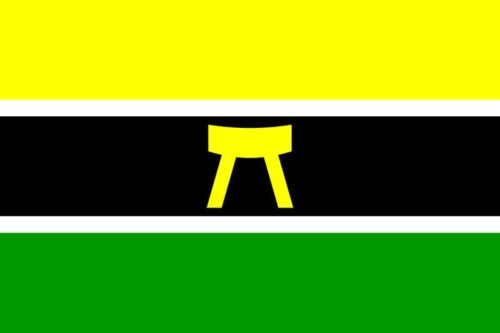
The Ashanti flag has three horizontal stripes: gold for mineral wealth, black for the Ashanti people, and green for the forests. The emblem in the centre is the Golden Stool, a symbol of national unity and royal authority since the 18th century.
The separate Asante chiefdoms were united by Osei Tutu in the 1670s and in 1696 he took the title of Asantehene and founded the Asante Empire. His nation rapidly became more powerful by forming alliances with neighbouring peoples, leading to the formation of the ‘Ashanti’ Union around 1700. He built a capital, Kumasi, and created the legend of the Golden Stool to legitimize his rule. The throne became the symbol of Asante authority. By 1750, the Asante Empire was the largest and most powerful state in the region.
The empire’s wealth and prosperity were based on mining and trading in gold and trading in slaves. The Asante also became famous for woodcarvings, furniture, and their brightly coloured woven cloth, called Kente. The kingdom continued to expand until, under King Osei Bonsu (1801-1824), Asante territory covered nearly all of present-day Ghana.
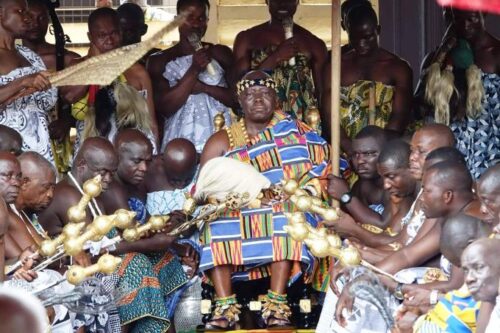
Otumfuo Osei Tutu II Asantehene is the King of the Asante Kingdom. (Photo: The Kingdom of Asante)
During the nineteenth century, the Asante fought several wars against British colonial power, but a series of defeats gradually weakened and reduced the territory. After the arrest and exile of Nana Prempeh I in 1896 and a final uprising in 1900, led by the Queen Mother Yaa Asantewaa, the Asantes were defeated. The British annexed their lands in 1902 and the empire was declared a Crown Colony. The exiled king, Nana Prempeh I, was allowed to return to Kumasi in 1924 and was reinstated as the occupant of the Golden Stool in 1926.
When he died in 1931, the Golden Stool passed to his nephew Nana Osei Agyeman Prempeh II. In 1970, the latter was succeeded by his nephew, Nana Opoku Ware II.
The present king, Osei Tutu II, is the nineteenth Asantehene.An oral tradition suggests that Chief Priest Komfo Anokye founded the Ashanti Kingdom after the Golden Stool miraculously descended from the sky and landed on the knees of Nana Osei Tutu. That is how Asantehene Osei Tutu I became the king of all the chiefdoms.
The Eight Clans
The Asantes live in Ashanti Region specifically in the capital of Kumasi metropolis. Getting to the end of the 17th century, three ‘Kum’ trees were planted at different places and only flourished and became a very big tree under which the King and his people often sat and so it became known as Kum-ase meaning ‘under Kum’.
The Ashanti Region is known for its major gold bar and cocoa production. The largest city and regional capital is Kumasi. As the largest tribe in Ghana and one of the few matrilineal societies in West Africa, they speak Twi, a language also spoken by many Ghanaians and the commonest dialect easily learned by children of other tribes in Ghana.
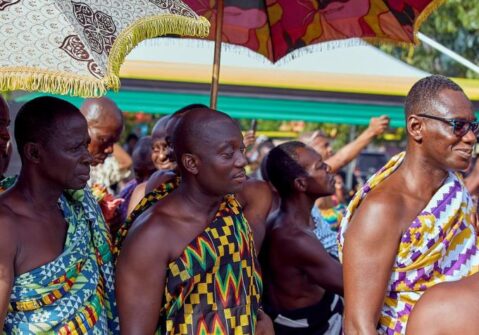
Many Asante people generally belong to the Asona clan. (Photo: The Kingdom of Asante)
In Asante tribe, the family line is matrilineal where inheritance passes from the mother to her children. The Golden Stool is also passed down matrilineally, to one of the king’s maternal nephews.
The Asantes have eight clans – Oyoko, Bretuo, Agona, Asona, Asenie, Aduana, Ekuona, and Asakyiri.
There is an Akan saying that the clan is not like a tune that you can change simply because you don’t like it. It falls on the people within the clan to improve it. These clans have towns founded by their ancestors so each of the clans exercises authority over towns. Chiefs for the towns are selected from the male members of the clans. One important thing to note is that the children of the female members of the clans are the royals of the town but the children of the male members are not members of the clan, so they are not royals of the town.
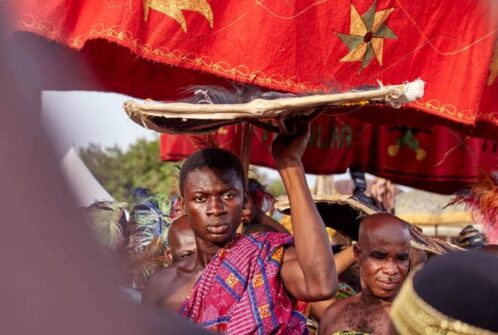
As the largest tribe in Ghana and one of the few matrilineal societies in West Africa, they speak Twi. (Photo: The Kingdom of Asante)
Many Asante people generally belong to the Asona clan than to any other clan. The symbol of Asona clan is the crow or wild boar and its characteristic is wisdom. The symbol of the Oyoko clan is falcon and its characteristic is patience. It is also the clan from which the Asantehene comes while the Bretuo clan has as its symbol the leopard and its characteristic is aggressiveness and exceptional bravery. The Agona clan has the symbol of the parrot and members of this clan are eloquent. As a tradition and custom, it is recommended never to pick a fight with a person from this clan because he or she is likely to have a clan member within the vicinity who will quickly come to his or her aid.
On the part of the Asenie clan, the symbol is the bat, and the characteristics of this clan are bravery and diplomacy. The Aduana clan believe that at the time of creation, their ancestors descended from the skies on a golden chain.
Others believe that they originally came from Asumanya and they were led by a duiker with a flame in his mouth and gold in his cheeks.
The Ekuona clan are not found in great numbers in Asante. The symbol of this clan is the buffalo, and its characteristic is uprightness. For the Asakyiri clan, the claim is that they were the first to be created by God. Their characteristics are beauty and patience.
Between Blood and Spirit
All the Akan tribes believe that they are made up of two elements, blood and spirit, both of which they obtain from their parents. To the Ashanti, the family and the mother’s clan are most important. A child is said to inherit the father’s soul or spirit and from the mother a child receives flesh and blood. This relates them more closely to the mother’s clan. The Ashanti live in an extended family.
Since Asantes are matrilineal, a child is what his or her mother is. Inheritance, succession, and status are lineally determined.
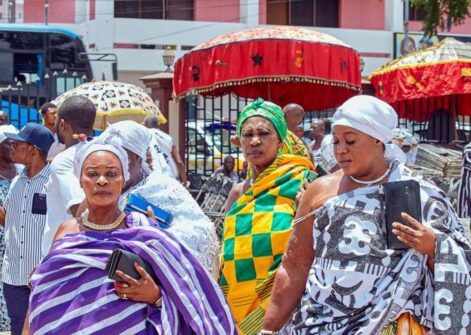
To the Ashanti, the family and the mother’s clan are most important. (Photo: The Kingdom of Asante)
They practice many ceremonies including birth, puberty, marriage, good harvests, and death. One of the oral traditions regarding the beliefs of the Asante is about the significance of the stool. Generally, it is customary for any lineage to have a stool. That is because it serves, among other things, as the symbol of authority.
Also, when children start crawling, their parents give them the stool as a gift. When young women reach puberty, they must sit on the stool, as per the dictates of the puberty rites. During a marriage ceremony, husbands present to their wives the stool. At death, the elders bathe the deceased on a ceremonial stool before burial. The stool is so significant to the beliefs and cultural practices of the Ashanti because it illustrates its ability to represent the soul of a person.
The Asantes traditionally have an abundance of food supplies and those they grow include plantains, cassava, maize, cocoa, vegetables,
cereals, legumes, and yams.
They eat different foods to celebrate their culture and bring people together. These foods include Fufu made from any of the starchy provisions that include plantains, yams, or cassava. Mpoto Mpoto is another food of the Asante people made from yams with the ingredients: onions, tomatoes, pepper, fish, and salt.
Kente, a prestigious piece of cloth
Asantes value their traditional clothing, especially the Kente, a prestigious piece of cloth that they have worn for many traditional occasions. Kings and Chiefs wear it because it serves as a form of authority. King Osei Tutu I, the first Asantehene reserved
the cloth for the royals.
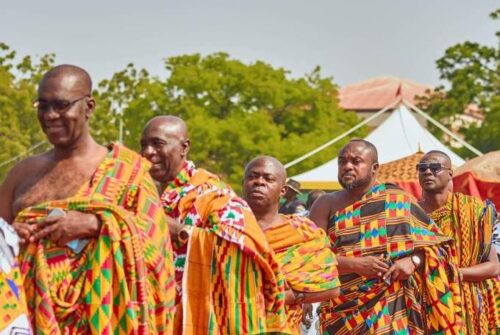
The Kente is a prestigious piece of cloth that is worn by the Asante people on many traditional occasions. (Photo: The Kingdom of Asante)
Traditionally, the Kente cloth is a festival cloth worn mainly during the annual and seasonal festivals, which are happy occasions. Each colour on the Kente cloth has a symbolic meaning.
For example, yellow, which is typical on almost all Kentes, means beauty, fertility, preciousness, royalty, and wealth. Gold means glory, high status, royalty, spiritual purity, and wealth.
Asante oral tradition and spiritual values build on the feelings of profound respect for the land, traditions, and culture. The Asante religion, for example, combines supernatural and spiritual powers. As part of the Akan ethnic group, they believe that everything has a soul, especially animals, trees, and other plants.
They also believe in supernatural beings and other magical powers, including witches, forest monsters, and fairies. Although some Asantes of today have converted to Islam and Christian denominations, the people still believe in the traditional religion that paid respect to ancestors, higher gods, spirits, and supreme beings. (Photo: Courtesy of The Kingdom of Asante)
(D.D.D.A.)



